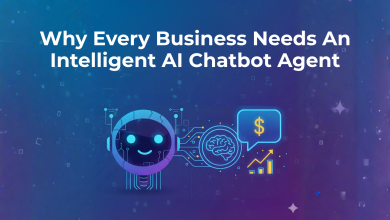
A decade ago, generative AI was a futuristic idea reserved for tech companies and early adopters. Now, it’s available to everyone and actively shaping how brands present themselves and how they connect with their target audience.
People often think AI is here to replace human creativity. What they don’t realize is how transformative AI can be when it is used to accelerate creativity. When used in branding and advertising, these tools can give businesses the room to experiment, refine, and push campaigns out faster than ever, ultimately helping them scale.
Instead of waiting for weeks to activate one polished concept, teams can now explore countless variations in a single afternoon, test them against real audiences on the same day, and quickly learn what resonates and what doesn’t. When AI sits beside human imagination, it amplifies the marketing possibilities for every business.
Brand Visual Identity And Creative Exploration
One of the most visible ways companies use generative AI is in shaping their visual identity. Tools like an AI image generator allow designers to spin up logos, mood boards, and campaign imagery in minutes, not weeks.
But this doesn’t mean that brands are replacing designers with machines. Instead, it gives teams a wider canvas to play with, helping them test multiple directions before settling on one that feels right.
A seasonal campaign can have its own look, a regional ad can carry local flavor, and all of this can be created without blowing through budgets.
Here, balance is crucial. Human judgment still decides what stays and what goes, ensuring that the final result feels intentional, polished, and undeniably on-brand.
When AI is guided by clear style rules and creative oversight, the outcome is a faster process without losing authenticity.
Personalized Advertising At Scale
Modern advertising thrives on relevance, and generative AI makes personalization more practical than ever. Instead of producing one-size-fits-all campaigns, businesses can tailor visuals and copy for different markets, languages, and even individual customers.
This is where AI shines. It can generate dozens of ad variations, each designed for a specific segment, and run them simultaneously. Teams can then measure which creative hits home and refine it in real time.
The result is advertising that feels less jumbled and more like a genuine conversation. However, personalization has to be done carefully. If it becomes too intrusive, it risks alienating people.
Brands that get it right use AI to enhance relevance while keeping customer trust intact. When done right, it can make people feel seen without crossing the line into manipulation.
Enhanced Consistency
Anyone who’s worked on large campaigns knows how challenging it is to keep brand voice consistent across every platform. This is where generative language models prove their worth.
Instead of starting from scratch each time, copywriters can use AI to draft headlines, taglines, and product descriptions that already align with brand tone. Writers don’t just accept the output as-is; they refine it, add nuance, and make sure the message feels personal.
Over time, companies build a library of prompts and frameworks that help AI “think” in their voice, making the first draft stronger and faster. Human oversight keeps the storytelling authentic, while AI ensures the voice doesn’t drift, even when teams are working at scale.
Dynamic Creative Optimization
AI is also changing the way brands run programmatic ads. Instead of static banners that repeat endlessly, campaigns can now generate variations that adapt in real time. The copy, imagery, and even product focus can shift based on location, time of day, or customer behavior.
Imagine an ad for a coffee brand that changes its message on a rainy morning versus a sunny afternoon. This kind of dynamic creative optimization makes ads more timely and, in turn, more engaging. But with this speed comes responsibility.
Brands need rules and oversight to make sure AI isn’t just spitting out endless variants that confuse rather than convert.
The best results come when media teams, creatives, and analysts work together to balance automation with strategy, ensuring that every variant still feels like it belongs to the same brand family.
Audience Research And Rapid Prototyping
Understanding your audience has always been the heart of great branding, and AI is helping companies move faster here, too. By analyzing social chatter, surveys, or customer feedback, generative tools can summarize insights and suggest campaign directions.
Teams can then use those insights to generate quick mockups and test them early, long before a full-scale launch. This kind of rapid prototyping saves both time and money, allowing brands to spot weak ideas early and double down on the strong ones. However, we must remember that AI doesn’t replace real customer validation.
Machines can generate concepts, but only human audiences can confirm whether those concepts resonate. Used well, this creates a more iterative process where creativity is grounded in feedback rather than guesswork.
Conversational Branding
AI is shaping how brands talk to customers directly. Chatbots and voice assistants are becoming natural extensions of brand personality.
With generative AI, these tools don’t just spit out generic answers; they can respond in a tone that matches the company’s identity. A playful brand can sound playful, while a luxury brand can maintain elegance and formality.
These conversational tools also lighten the load on customer service teams, handling FAQs and simple requests so humans can focus on complex problems. But here too, quality control matters.
If a chatbot sounds off-brand or provides incorrect information, it risks doing more harm than good. Brands that succeed in conversational AI design clear guardrails, monitor interactions, and make sure a human is always ready to step in when needed.
Ethics, Transparency, And Brand Trust
With all this new capability comes a serious responsibility. Consumers today are quick to spot when something feels artificial or misleading, and they don’t take kindly to being tricked.
If a brand uses AI to create synthetic content, it needs to be transparent about it. The same goes for avoiding biased or stolen material in AI outputs. Trust is fragile, and one misstep can undo years of brand building.
This is why forward-looking companies are building ethical guidelines into their AI practices from day one. Some even publish their standards publicly to show accountability. This is vital for protecting long-term reputation.
In an era where AI is everywhere, being honest and responsible with its use is one of the strongest differentiators a brand can have.
Measurement And Long-Term Strategy
Creating AI-driven campaigns is one thing; it’s another to measure whether they actually work. With so many variations and outputs, traditional metrics don’t always give the full picture.
This is why businesses are rethinking their measurement frameworks, focusing on outcomes like retention, engagement quality, and long-term customer value rather than just clicks.
Attribution models also need to adjust when dozens of ad variations are running at once. Without strong analytics, teams risk chasing novelty instead of results.
Companies that succeed with AI build systems that tie creative experiments directly to business goals. Just as important, they invest in training and governance so AI isn’t just a one-off experiment but an ongoing capability that scales responsibly over time.
Practical Steps For Teams
For companies considering AI, the smartest approach is to start small. A pilot campaign, a single chatbot, or a few ad variants can reveal both the opportunities and the challenges. From there, teams can build playbooks, define guardrails, and scale with confidence.
Generative AI doesn’t replace marketers; it gives them new tools to work smarter, faster, and more creatively.
Final Thoughts
AI is transforming branding and advertising not by taking creativity away, but by amplifying it. Businesses can explore ideas faster, deliver more relevant campaigns, and extend their brand voice into new channels with efficiency that was unthinkable a few years ago.
The key is balance: letting AI handle scale and speed while humans preserve authenticity, strategy, and emotional resonance. Companies that adopt this hybrid approach are discovering not just cost savings, but richer ways to connect with people.
As the technology evolves, the brands that thrive will be those that treat AI as a partner in creativity, not a replacement for it.




